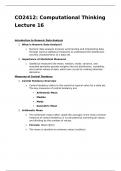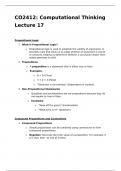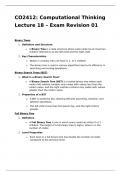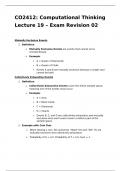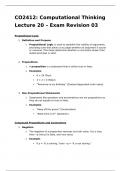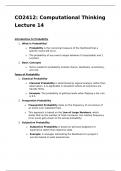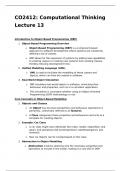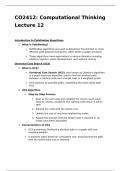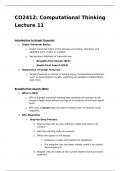University of Central Lancashire Preston (UCLAN)
Latest uploads at University of Central Lancashire Preston (UCLAN). Looking for notes at University of Central Lancashire Preston (UCLAN)? We have lots of notes, study guides and revision notes available for your school.
-
144
-
7
-
19
Courses at University of Central Lancashire Preston (UCLAN)
Notes available for the following courses at University of Central Lancashire Preston (UCLAN)
Latest notes & summaries University of Central Lancashire Preston (UCLAN)
This document contains comprehensive notes from Lecture 16 of the CO2412 course on Computational Thinking, focusing on numeric data analysis. The lecture provides an in-depth overview of statistical measures used to summarize and interpret data, helping to understand the distribution and key characteristics of a data set.
This document contains detailed notes from Lecture 17 of the CO2412 course on Computational Thinking, focusing on the fundamentals of propositional logic. The lecture provides a thorough introduction to propositional logic, which is used to assess the validity of arguments by applying logical rules to determine whether conclusions drawn from premises are sound.
This document contains detailed notes from Lecture 18 of the CO2412 course on Computational Thinking, focusing on key data structures and algorithms essential for exam preparation. The lecture provides an in-depth review of Binary Trees, Binary Search Trees (BSTs), Heaps, and Graph Theory, along with an introduction to Greedy Algorithms.
This document contains comprehensive notes from Lecture 19 of the CO2412 course on Computational Thinking, focusing on key probability concepts essential for exam preparation. The lecture provides a detailed review of mutually exclusive and collectively exhaustive events, joint and marginal probabilities, and the use of decision trees to calculate conditional probabilities.
This document contains detailed notes from Lecture 20 of the CO2412 course on Computational Thinking, focusing on exam revision topics including propositional logic and statistical measures. The lecture covers essential concepts such as the validity of arguments, logical equivalence, and key measures of central tendency and variation, providing a strong foundation for the upcoming exam.
This document contains comprehensive notes from Lecture 15 of the CO2412 course on Computational Thinking. The lecture focuses on the importance of organizing and presenting data graphically, which is essential for making raw data more interpretable and actionable. The notes cover various techniques for visually representing data, such as bar charts, pie charts, histograms, frequency distributions, and more.
This document contains comprehensive notes from Lecture 14 of the CO2412 course on Computational Thinking. The lecture introduces the fundamental concepts of probability, a crucial area in mathematics and statistics that measures the likelihood of events occurring. These notes cover the different types of probability, including classical, frequentist, and subjective probability, providing clear definitions and examples for each.
This document contains detailed notes from Lecture 13 of the CO2412 course on Computational Thinking. The lecture introduces the principles of Object-Based Programming (OBP), a component-based approach to software development that focuses on defining and simulating real-world objects through classes.
This document contains detailed notes from Lecture 12 of the CO2412 course on Computational Thinking. The lecture focuses on pathfinding algorithms, essential tools in computer science for determining the shortest or most efficient path between two points within a graph structure. These algorithms have broad applications, including robotics, logistics, game development, and network routing.
This document contains detailed notes from Lecture 11 of the CO2412 course on Computational Thinking. The lecture focuses on graph traversal, a fundamental concept in computer science that involves visiting and updating each vertex in a graph. The notes cover the two primary methods of graph traversal: Breadth-First Search (BFS) and Depth-First Search (DFS).

